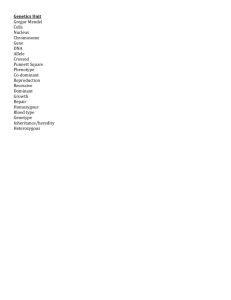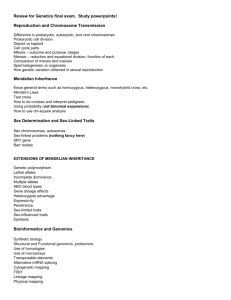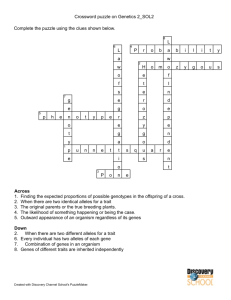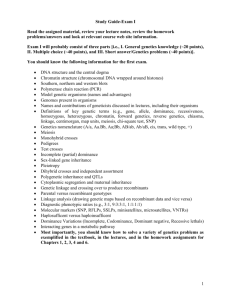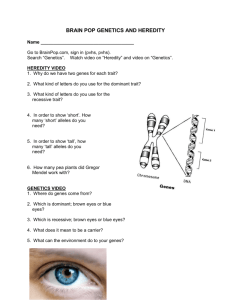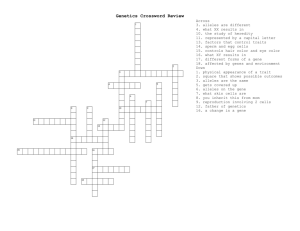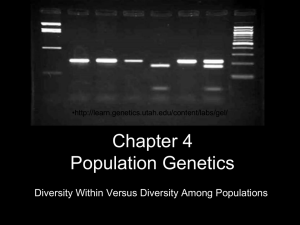Quantitative Genetic Perspectives on Loss of Diversity in Elite Maize
advertisement
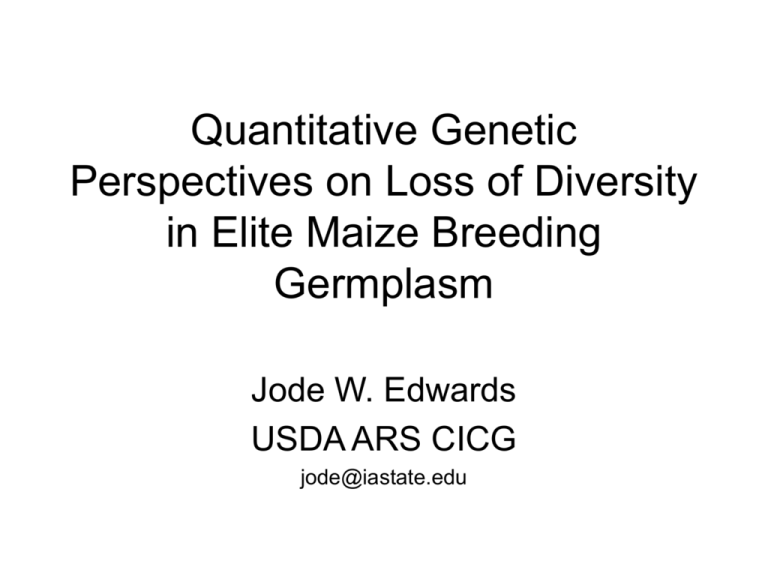
Quantitative Genetic Perspectives on Loss of Diversity in Elite Maize Breeding Germplasm Jode W. Edwards USDA ARS CICG jode@iastate.edu Outline • Diversity • Population genetics of maize • Quantitative genetic processes – Bottlenecks – Selection • Implications What is diversity? • D = 1 – Spi2 – pi = allele frequency • • At Hardy-Weinberg equilibrium D is an estimator of heterozygosity, H With population subdivision, heterozygosity is related to Fst: – Ht = (1-1/2N)tH0 = (1-Fst)H0 Sources: Nei, M, 1973, PNAS , 70:3321-3323; Wright, S., 1943, Genetics, 28:114-138 Diversity in Maize Inbreds and Landraces Tenaillon, Sawkins, Long, Gaut, Doebley, and Gaut, 2001 • Estimated SNP diversity by sequencing – – – – 7 known genes, 6 cDNA clones 8 RFLP clones All chromosome 1 • Germplasm – 16 exotic landraces (1 inbred per landrace) – 9 U.S. inbreds (B73, Mo24W, Mo17, W153R, Ky21, NC258, Oh43, Tx601, T8) • Inbreds contained 77% as much diversity as the landraces (DI/DL) Source: Tenaillon et al., 2001, PNAS, 98:9161-9166 Tenaillon et al. Conclusion • ‘the U.S. inbred sample retains a high proportion of diversity, which is difficult to explain given that U.S. elite germplasm has a narrow origin based largely on two open-pollinated varieties, Reid yellow dent and Lancaster (14)’ – [“(14)” is Major Goodman’s paper in Heredity] Is 77% Hard to Explain? E[1-Fst] = 0.89 • Subpopulation with Fst = 0.87, E[1-Fst] = 0.77 1 0.8 Heterozygosity • 1 - Fst = 1 - 0.77 • For Fst of 0.23, N=2.2 If inbreds were: • Sampled randomly, 0.6 0.4 0.2 0 0 25 50 Inbred lines 75 100 How should we measure diversity? Heterozygosity (formally)? Number of alleles? Number of polymorphic loci? Number of rare alleles? JE thoughts: Diversity is important, but we don’t know how to measure it (or what it is) Something else may be more important Sustainable Selection Response • Plant breeders’ main goal is selection – Short term: Maximum response – Long term: Sustainable response • In order to address sustainability of selection response, we need to understand phenotype – Population genetics of maize – Quantitative genetics of population bottlenecks – Quantitative genetics of selection with finite size Maize Population Genetics: BSSS • Started with maize land races (O.P.) and develop ‘first cycle’ inbreds • 16 lines intermated to form BSSSC0 – Expected diversity = 87.5% of ancestor • B14, B37 emerge from Cycle zero – Expected diversity = .875 x .5 = 43.75% • B73, B84 emerge from C5, C7 Corn Belt Maize Land Races • • • • Outcrossing, monoecious populations Large Ne (?) Mass selected for visual characteristics (low h2?) Corn belt dents existed 100+ generations, longer for other groups • Corn belt dents (Labate et al., 2003) – Accessions: Fst = 0.15 – Varieties: Fst = 0.04 • “Almost” one large randomly mated population Source: Labate, J.A. et al., 2003, Crop Science, 43:80-91 Maize Land Races • Hardy-Weinberg equilibrium • Linkage equilibrium • Mutation-selection equilibrium Haldane (1937) Principle • Mutation frequencies determined by equilibrium – New mutations are constantly added to the population – Mutations removed by selection (and drift) – Mutation rates estimated to be 0.4 – 1.0 per diploid individual per generation • At equilibrium – Individuals carry many mutations – Reduction in fitness due to mutations = “genetic mutation load” (Muller) Source: Haldane, J.B.S., 1937, The American Naturalist, 71:337-359; Crow, J.F., 1993, Oxford Surveys in Evolutionary Biology, 9:3-42 Does Mutation Load Apply to Maize? • Inbreeding depression – Severe in first cycle inbreds – Less in germplasm with inbreeding history (purging of recessives) – If many loci carry mutations, complete purging takes many generations • Observation of major “lethal” mutations • Empirical work in maize is needed! Significance of Haldane Principle • Mutation load provides a model of quantitative genetic variation more realistic than ‘infinitessimal theory’ • Provides a basis for understanding quantitative genetic variation, and thus, • Basis for predicting effects of bottlenecks and artificial selection Bottlenecks • Population is formed from small number of individuals – Change allele frequencies – Hardy-Weinberg and linkage disequilibria • Under additive model – ‘within subpoplation variance’, Vw = (1-Fst) s2A – ‘among subpopulation variance’, Vb =2Fst s2A • Non-additive model: effects of bottlenecks are complex Source: Wang, J., et al., 1998, Genetics, 150:435-447 Edwards and Lamkey (2003) Within-Subpopulation Variances: BS13(S)C0 1.4 Vw (YLD) Vw (PHT) 1.2 V w Variance 1.0 0.8 0.6 (MS T) VA (M ST) VA (YLD) 0.4 VA (PHT) 0.2 0.0 0.0 0.2 0.4 0.6 0.8 FST Source: Edwards and Lamkey, 2003, Crop Science, 43:2006-2017 1.0 Garcia, Lopez-Fanjul, and Garcia-Dorado, 1994 D. melanogaster, Full-sib lines 160 Variance 120 80 40 0 0 0.25 0.5 Inbreeding Coefficient Source: Garcia, N., et al., 1994, Evolution, 48:1277-1285 0.75 Gene Effect Sizes Wang, Caballero, Keightley, and Hill, 1998 Percent of additive variance 80 70 60 50 40 30 20 10 0 0-50 50-100 100200 200300 300400 400500 >500 lethals Effect size (Ne x s) Source: Wang, J., et al., 1998, Genetics, 150:435-447 Gene Effects and Bottlenecks • Genes of all sizes important in the base • After a bottleneck: large recessives become much more important (and hence large increase in dominance) • Explanation: Nonlinear relationship between frequency and variance: small increase in frequency = large increase in variance Limits to Selection Response Robertson, 1960 • Max response = 2 Ne times initial response • Half-life occurs at 1.4 Ne generations • Total response is maximized at 50% intensity (greater with linkage) • Based on ‘infinitessimal’ theory – Many genes of ‘infinitely’ small effect – Can we understand ‘side effects’ of selection under more realistic conditions? Source: Robertson, A., 1960, Proc. Roy. Soc. London, Ser. B, 153:235-249 Selection Effects • Loss of heterozygosity (diversity) • Linkage disequilibrium – Bulmer – Hill-Robertson • Epistasis Linkage and Selection • Bulmer effect – Correlation between alleles induced by selection – Causes excess of coupling phase linkages and reduced genetic variance • Hill-Robertson effect – Effect of repulsion phase linkages – Unfavorable alleles become fixed because of selection for favorable alleles linked in repulsion phase Sources: Bulmer, M.G., 1971, American Naturalist, 105:201-211; Hill, W.G. and Robertson, A., 1968, Theor. Appl. Genet., 38:226-231 Zhang and Hill, 2005 • Simulated selection in cage populations derived from ‘equilibrium natural populations’ of D. melanogaster • Conditions – Genetic model: mutation-selection balance under joint pleiotropic and stabilizing selection – 40% intensity – Recombine 40 individuals – VG0 = 0.5 VE – 3 chromosomes of varying length Source: Zhang, X.S., and Hill, W.G., 2005, Genetics, 169:411-425 Selection and Linkage Zhang and Hill, 2005 Source: Zhang, X.S., and Hill, W.G., 2005, Genetics, 169:411-425 Gene Numbers and Effects Zhang and Hill, 2005 • Distribution of gene effects – 90% of genes have a<0.1sp and account for 27% of genetic variance – 10% of genes have a>0.1sp and account for the rest of the genetic variance • Estimated that 103 – 104 loci are polymorphic in a cage population Source: Zhang, X.S., and Hill, W.G., 2005, Genetics, 169:411-425 Evidence of Linkage in Maize • Degree of dominance, d, can be estimated as a ratio, sD2/sA2, in F2-derived populations • Linkage disequilibrium causes a bias called ‘associative overdominance’ • Random mating breaks up linkage and reduces bias Aa -> d=2 AA Aa -> d=1 Aa -> d=0 aa Maize NCIII Experiments 1.8 Average degree of dominace 1.6 1.4 1.2 Gardner Lonnquist 1 0.8 0.6 0.4 0 3 6 9 12 15 Generations random mated Lonnquist, J.H., 1980, Anal. Acad. Nac. Cs. Ex. Fis. Nat., 32:195-201; Gardner, C. O., Personal communication to E.T. Bingham Epistasis • Favorable epistatic interactions are increased by selection • Lamkey, Schnicker, and Melchinger, 1995 – Began with BSSS lines B73 (cycle 5) and B84 (cycle 7) – Formed the F1, F2, BC1 (to both parents) and intermated F2 – Testcrossed all generations onto Mo17 – With additive model (no epistasis) there is a linear relationship among generations Source: Lamkey, K.R., et al., 1995, Crop Science, 35:1272-1281 Epistasis in B73 and B84 Lamkey, Schnicker, and Melchinger, 1995 Source: Lamkey, K.R., et al., 1995, Crop Science, 35:1272-1281 How did we get here? • Bottleneck followed by 5 and 7 cycles of selection • During selection – Linkage disequilibrium increases – Epistatic combinations become more important – Selection may be dominated by genes of large effect • Slow increase in frequency of many small favorable alleles is not a good model – For positive effects, i.e., response – For negative effects Sustainable Response is a Function of More than Diversity • Loss of alleles (diversity) • Increase in linkage disequilibrium (reduced variance) • Increased dependence on specific epistatic combinations • Shift in size of genes that contribute to genetic variance (small to big) Implications for Elite x Exotic Crosses • Genetic variance within a single population is due mostly to genes of large effect • Linkage disequilibrium within the cross may reduce genetic variance • Any new alleles from the exotic parent are preferentially lost if: – Linked to negative alleles at physiologically selected loci, e.g., photoperiod – There are favorable epistatic interactions among elite alleles What can be done? • Map major genes (especially photoperiod) and use markers to break linkages • Recycle lines from different crosses • Enhance or improve land races directly to maintain more variation and reduce disequilibrium – If major genes were identified, could speed up with markers – Preserve more variation due to genes of small effect • Random mate individual crosses Basic Research Questions • How differentiated are maize land races from each other and from elite lines? – At neutral loci – At selected loci • Can we identify major genes that – Differentiate elite lines from ancestral varieties – Corn belt dent from tropical races • Genetic architecture – Can we estimate mutation load parameters? – Can we distinguish purging of recessive load from selection for physiological effects We can succeed doing what we are already doing However, can we be more successful?
